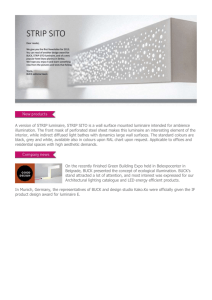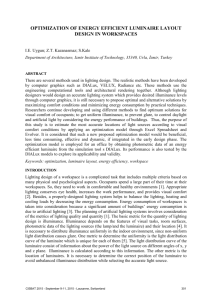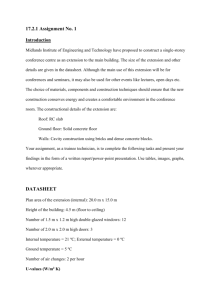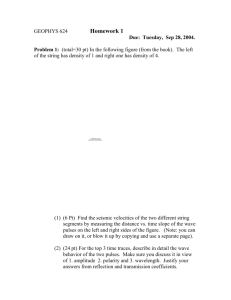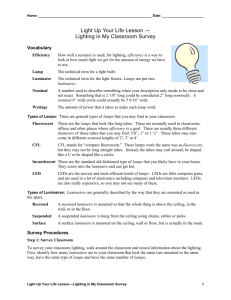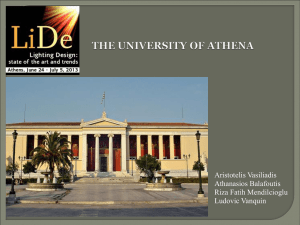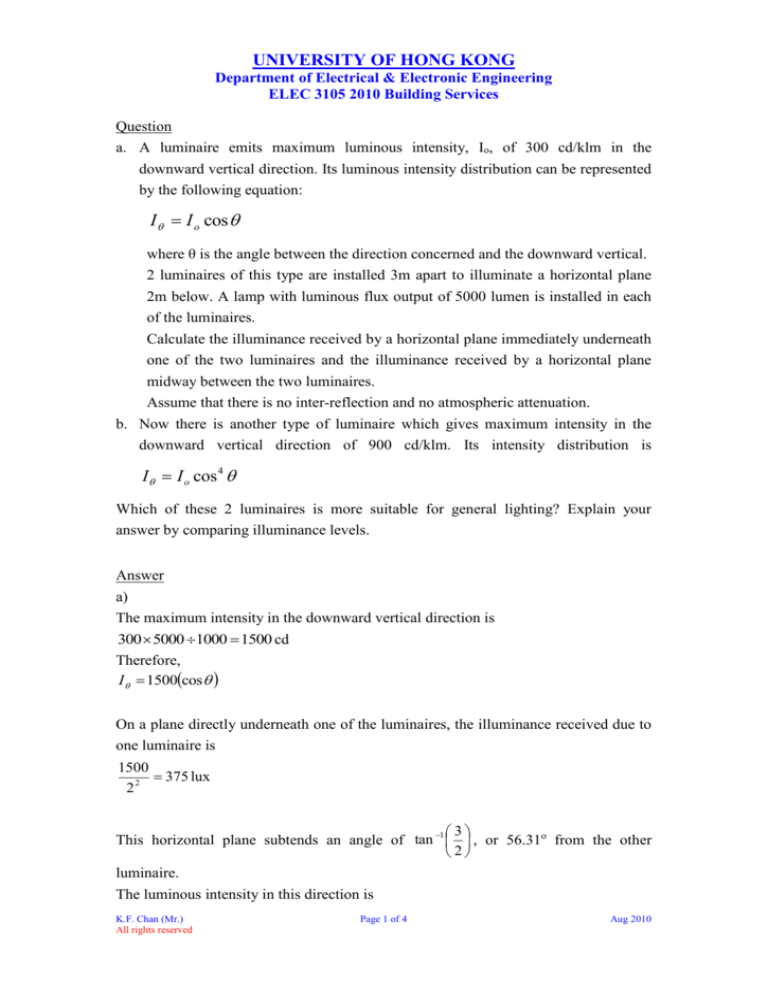
UNIVERSITY OF HONG KONG
Department of Electrical & Electronic Engineering
ELEC 3105 2010 Building Services
Question
a. A luminaire emits maximum luminous intensity, Io, of 300 cd/klm in the
downward vertical direction. Its luminous intensity distribution can be represented
by the following equation:
I I o cos
where θ is the angle between the direction concerned and the downward vertical.
2 luminaires of this type are installed 3m apart to illuminate a horizontal plane
2m below. A lamp with luminous flux output of 5000 lumen is installed in each
of the luminaires.
Calculate the illuminance received by a horizontal plane immediately underneath
one of the two luminaires and the illuminance received by a horizontal plane
midway between the two luminaires.
Assume that there is no inter-reflection and no atmospheric attenuation.
b. Now there is another type of luminaire which gives maximum intensity in the
downward vertical direction of 900 cd/klm. Its intensity distribution is
I I o cos 4
Which of these 2 luminaires is more suitable for general lighting? Explain your
answer by comparing illuminance levels.
Answer
a)
The maximum intensity in the downward vertical direction is
300 5000 1000 1500 cd
Therefore,
I 1500cos
On a plane directly underneath one of the luminaires, the illuminance received due to
one luminaire is
1500
375 lux
22
3
This horizontal plane subtends an angle of tan 1 , or 56.31o from the other
2
luminaire.
The luminous intensity in this direction is
K.F. Chan (Mr.)
All rights reserved
Page 1 of 4
Aug 2010
UNIVERSITY OF HONG KONG
Department of Electrical & Electronic Engineering
ELEC 3105 2010 Building Services
1500 cos 56.31o = 832.05cd
Thus illuminance received by this point due to the other luminaire is
832.05
cos 3 56.31o
2
2
= 35.5lux
Therefore total illuminance received by a plane directly underneath a luminaire is
375 + 355 = 410.5 lux
For a horizontal plane midway between the 2 luminaires, it subtends an angle of
1.5
tan 1 , or 36.87o from either luminaire.
2
The luminous intensity in this direction is
1500 cos 36.87 o = 1200cd
The illuminance received by this plane from one of the luminaires is
1200
cos 3 36.87 o
2
2
= 153.6lux
The total illuminance received is thus 153.6 + 153.6 = 307.2 lux
b)
Let’s repeat the above calculations for this new luminaire.
The maximum intensity in the downward vertical direction is
900 5000 1000 4500 cd
Therefore
I 4500 cos 4
On a plane directly underneath one of the luminaires, the illuminance received due to
one luminaire is
4500
1125 lux
22
3
This horizontal plane subtends an angle of tan 1 , or 56.31o from the other
2
luminaire.
The luminous intensity in this direction is
K.F. Chan (Mr.)
All rights reserved
Page 2 of 4
Aug 2010
UNIVERSITY OF HONG KONG
Department of Electrical & Electronic Engineering
ELEC 3105 2010 Building Services
4500 cos 4 45o = 426cd
Thus illuminance received by this point due to the other luminaire is
426
cos 3 56.31o
2
2
= 18.2lux
Therefore total illuminance received by a plane directly underneath a luminaire is
1125 + 18.2 = 1143.2 lux
For a horizontal plane midway between the 2 luminaires, it subtends an angle of
1.5
tan 1 , or 36.87o from either luminaire.
2
The luminous intensity in this direction is
4500 cos 4 36.87 o = 1843.2cd
The illuminance received by this plane from one of the luminaires is
1843.2
cos 3 36.87 o
2
2
= 235.9lux
The total illuminance received is thus 235.9 + 235.9 = 471.9 lux
The ratio of illuminance using luminaire in (a) is
307.2
0.75
410.5
The ratio of illuminance using luminaire in (b) is
471.9
0.41
1143.2
Uniformity of illuminance is found to be better when using luminaire in (a).
Therefore, the type of luminaire in (a) is more suitable for general lighting.
If the spacing is wider, the uniformity given by luminaire type (b) can be found to be
even worse.
K.F. Chan (Mr.)
All rights reserved
Page 3 of 4
Aug 2010
UNIVERSITY OF HONG KONG
Department of Electrical & Electronic Engineering
ELEC 3105 2010 Building Services
In fact, the polar curves of the 2 luminaires looks like something below:
The one in (b) will be more suitable for use in accent lighting while the one in (a)
more suitable for general lighting.
[Example taken from ELEC 3105 2007/08 exam]
K.F. Chan (Mr.)
All rights reserved
Page 4 of 4
Aug 2010

